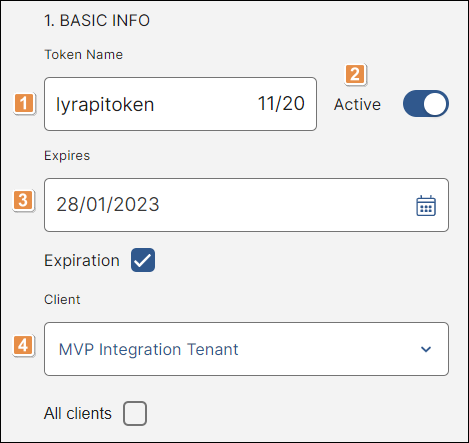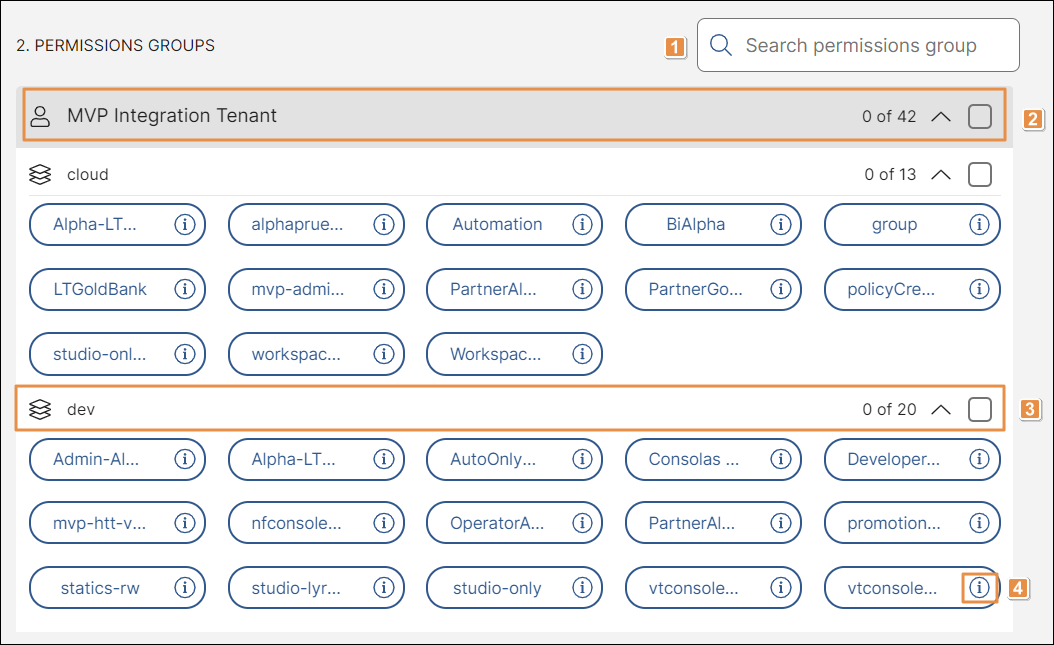Create or Edit an API Token
To create an API Token, go to the API Tokens page and click + New API Token. In the Create API Token page that opens, set the basic information and permission groups for the token. Refer to the sections below to learn more.
Basic Info
In this section, you complete the API token's basic settings. Refer to the annotated image below to learn more.

Token Name. Enter a unique name for the token. This field is mandatory.
Note
You can only use lowercase characters, digits, hyphens and underscores to complete this field. Uppercase and special characters are not supported.
Active. Toggle that shows if the token is active or inactive. By default, the status is Active. To deactivate the token, click the toggle.
Expires. Date on which the API token expires. By default, the expiration field is disabled (grayed out). To set an expiration date, click the Expiration checkbox. Then, click the date field or the calendar icon and select a date. This field is optional.
Client. Client to which the API Token is associated. Click the arrow and select a client from the drop-down menu.
Important
The Client field is only available for partner and superadmin users. The All Clients checkbox is available for superadmin users only.
After completing the Basic Info section, you must complete the Permissions Groups section.
Permissions Groups
In this section, you select the permission groups for the products within the Veritran platform that you want to integrate with the API token. Refer to the annotated image below to learn more.
Important
Client users have this section available by default. In the case of partner and superadmin users, this section only becomes available after the Client field in the Basic section is completed.

Search bar. To find a permissions group, click the search bar and type its name.
Permission groups per client. Click the checkbox to select all the permissions set for every environment of the client. The number located to the left of the checkbox reflects the number of permissions selected for that client (blue-colored chips) and associated to the API token.
Permission group per environment. You can select permissions groups in bulk or individually. To select all the permissions groups within one environment, click the checkbox. To select permissions groups individually, click each permission group chip. The number located to the left of the checkbox reflects the number of permissions groups selected for that environment (blue-colored chips) and associated to the API token.
Tip
Client permissions groups are identified with a person icon located to the left of the group's name. Environment permissions groups are identified with a stack icon located to the left of the group's name.
Permission group details. Click the information icon located to the right of the permission group chip to see or edit that permission's settings. A panel opens, containing the details on the client, environment and environment version, and the permissions granted. Click Go Back to go back to the API token's settings. Click Edit to go to the permission group's settings and make all the necessary changes.
Once you complete all the required fields, click Create. A popup message appears, confirming that the API token was successfully created. In addition, a modal opens, containing the token link. Click Copy Token and Close to copy the token and go back to the list of API tokens.
To edit an API token from the API Tokens page, find it in the list, click the vertical three-dot icon to the right and then click Edit. The Edit API Token page opens, where you can modify the API token's basic info and permissions. The edit page allows you to modify the same fields you completed when creating the API Token. Click Save to confirm changes. A popup message appears, confirming that the API token was successfully updated.